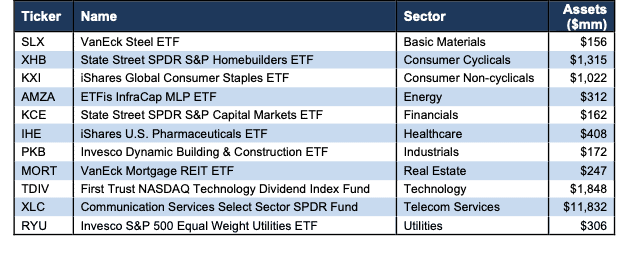With an ever-growing list of similar-sounding ETFs to choose from, finding the best is an increasingly difficult task. How can investors change the game to shift the odds in their favor?
Don’t Trust ETF Labels
There are at least 75 different Technology ETFs and at least 291 sector-focused ETFs across eleven sectors. Do investors need 26+ choices on average per sector? How different can the ETFs be?
Those 75 Technology ETFs are very different from each other. With anywhere from 20 to 565 holdings, many of these Technology ETFs have drastically different portfolios with differing risk profiles and performance outlooks.
The same is true for the ETFs in any other sector, as each offers a very different mix of good and bad stocks. Basic Materials ranks first for stock selection Real Estate ranks last. Details on the Best & Worst ETFs in each sector are here.
Avoiding Analysis Paralysis
We think the large number of sector ETFs hurts investors more than it helps. Manually conducting a deep analysis for every ETF is simply not a realistic option, exposing investors to insufficient analysis and missing profitable opportunities. Analyzing ETFs, with the proper diligence[1], is far more difficult than analyzing stocks because it means analyzing all the stocks within each ETF. As stated above, there can be as many as 565 stocks or more for one ETF.
Anyone focused on fulfilling the fiduciary duty of care recognizes that analyzing the holdings[2] of an ETF is critical to finding the best ETF. More reliable & proprietary fundamental data, proven in The Journal of Financial Economics, drives our research and analysis of ETF holdings and provides investors with a new source of alpha. Figure 1 shows our top-rated ETF for each sector.
Figure 1: The Best ETF in Each Sector
* Best ETFs exclude ETFs with TNAs less than $100 million for inadequate liquidity
Sources: New Constructs, LLC and company filings
Amongst the ETFs in Figure 1, State Street SPDR S&P Capital Markets ETF (KCE) ranks first overall, VanEck Steel ETF (SLX) ranks second, and State Street SPDR S&P Homebuilders ETF (XHB) ranks third. VanEck Mortgage REIT ETF (MORT) ranks last.
How to Avoid “The Danger Within”
Why do you need to know the holdings of ETFs before you buy?
You need to be sure you do not buy an ETF that might blow up. Buying an ETF without analyzing its holdings is like buying a stock without analyzing its business and finances. No matter how cheap, if it holds bad stocks, the ETF’s performance will be bad. Don’t just take my word for it, see what Barron’s says on this matter.
PERFORMANCE OF FUND’S HOLDINGS = PERFORMANCE OF FUND
Analyzing each holding within funds is no small task. Our Robo-Analyst technology enables us to perform this diligence with scale and provide the research needed to fulfill the fiduciary duty of care. More of the biggest names in the financial industry (see At BlackRock, Machines Are Rising Over Managers to Pick Stocks) are now embracing technology to leverage machines in the investment research process. Technology may be the only solution to the dual mandate for research: cut costs and fulfill the fiduciary duty of care. Investors, clients, advisors and analysts deserve the latest in technology to get the diligence required to make prudent investment decisions.
If Only Investors Could Find Funds Rated by Their Holdings
Our ETF ratings leverage our stock coverage. We rate ETFs based on the aggregated ratings of the stocks each ETF holds.
State Street SPDR S&P Capital Markets ETF (KCE) is not only the top-rated Financials ETF but is also the overall top-ranked sector ETF out of the 291 sector ETFs that we cover.
The worst ETF in Figure 1 is VanEck Mortgage REIT ETF (MORT), which gets a Neutral rating. One would think ETF providers could do better for this sector.
This article originally published on April 28, 2022.
Disclosure: David Trainer, Kyle Guske II, and Matt Shuler receive no compensation to write about any specific stock, sector, or theme.
Follow us on Twitter, Facebook, LinkedIn, and StockTwits for real-time alerts on all our research.
[1] Three independent studies from respected institutions prove the superiority of our data, models, and ratings. Learn more here.
[2] Harvard Business School features the powerful impact of our research automation technology in the case New Constructs: Disrupting Fundamental Analysis with Robo-Analysts.

